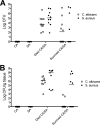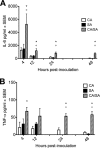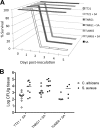Morphogenesis is not required for Candida albicans-Staphylococcus aureus intra-abdominal infection-mediated dissemination and lethal sepsis
- PMID: 24891104
- PMCID: PMC4136217
- DOI: 10.1128/IAI.01746-14
Morphogenesis is not required for Candida albicans-Staphylococcus aureus intra-abdominal infection-mediated dissemination and lethal sepsis
Abstract
Intra-abdominal polymicrobial infections cause significant morbidity and mortality. An established experimental mouse model of Staphylococcus aureus-Candida albicans intra-abdominal infection results in ∼60% mortality within 48 h postinoculation, concomitant with amplified local inflammatory responses, while monomicrobial infections are avirulent. The purpose of this study was to characterize early local and systemic innate responses during coinfection and determine the role of C. albicans morphogenesis in lethality, a trait involved in virulence and physical interaction with S. aureus. Local and systemic proinflammatory cytokines were significantly elevated during coinfection at early time points (4 to 12 h) compared to those in monoinfection. In contrast, microbial burdens in the organs and peritoneal lavage fluid were similar between mono- and coinfected animals through 24 h, as was peritoneal neutrophil infiltration. After optimizing the model for 100% mortality within 48 h, using 3.5 × 10(7) C. albicans (5× increase), coinfection with C. albicans yeast-locked or hypha-locked mutants showed similar mortality, dissemination, and local and systemic inflammation to the isogenic control. However, coinfection with the yeast-locked C. albicans mutant given intravenously (i.v.) and S. aureus given intraperitoneally (i.p.) failed to induce mortality. These results suggest a unique intra-abdominal interaction between the host and C. albicans-S. aureus that results in strong inflammatory responses, dissemination, and lethal sepsis, independent of C. albicans morphogenesis.
Copyright © 2014, American Society for Microbiology. All Rights Reserved.
Figures









Similar articles
-
Candida albicans Augments Staphylococcus aureus Virulence by Engaging the Staphylococcal agr Quorum Sensing System.mBio. 2019 Jun 4;10(3):e00910-19. doi: 10.1128/mBio.00910-19. mBio. 2019. PMID: 31164467 Free PMC article.
-
Morphology-Independent Virulence of Candida Species during Polymicrobial Intra-abdominal Infections with Staphylococcus aureus.Infect Immun. 2015 Oct 19;84(1):90-8. doi: 10.1128/IAI.01059-15. Print 2016 Jan. Infect Immun. 2015. PMID: 26483410 Free PMC article.
-
Immune Protection against Lethal Fungal-Bacterial Intra-Abdominal Infections.mBio. 2018 Jan 16;9(1):e01472-17. doi: 10.1128/mBio.01472-17. mBio. 2018. PMID: 29339423 Free PMC article.
-
Metabolic Adaptations During Staphylococcus aureus and Candida albicans Co-Infection.Front Immunol. 2021 Dec 8;12:797550. doi: 10.3389/fimmu.2021.797550. eCollection 2021. Front Immunol. 2021. PMID: 34956233 Free PMC article. Review.
-
Impact of Staphylococcus aureus on pathogenesis in polymicrobial infections.Infect Immun. 2014 Jun;82(6):2162-9. doi: 10.1128/IAI.00059-14. Epub 2014 Mar 18. Infect Immun. 2014. PMID: 24643542 Free PMC article. Review.
Cited by
-
Oropharyngeal and intestinal concentrations of opportunistic pathogens are independently associated with death of SARS-CoV-2 critically ill adults.Crit Care. 2022 Oct 3;26(1):300. doi: 10.1186/s13054-022-04164-0. Crit Care. 2022. PMID: 36192756 Free PMC article.
-
The impact of the Fungus-Host-Microbiota interplay upon Candida albicans infections: current knowledge and new perspectives.FEMS Microbiol Rev. 2021 May 5;45(3):fuaa060. doi: 10.1093/femsre/fuaa060. FEMS Microbiol Rev. 2021. PMID: 33232448 Free PMC article. Review.
-
Streptococcus agalactiae Inhibits Candida albicans Hyphal Development and Diminishes Host Vaginal Mucosal TH17 Response.Front Microbiol. 2018 Feb 23;9:198. doi: 10.3389/fmicb.2018.00198. eCollection 2018. Front Microbiol. 2018. PMID: 29527193 Free PMC article.
-
A fungal metabolic regulator underlies infectious synergism during Candida albicans-Staphylococcus aureus intra-abdominal co-infection.Nat Commun. 2024 Jul 9;15(1):5746. doi: 10.1038/s41467-024-50058-w. Nat Commun. 2024. PMID: 38982056 Free PMC article.
-
Oropharyngeal Candidiasis: Fungal Invasion and Epithelial Cell Responses.PLoS Pathog. 2017 Jan 12;13(1):e1006056. doi: 10.1371/journal.ppat.1006056. eCollection 2017 Jan. PLoS Pathog. 2017. PMID: 28081240 Free PMC article. Review. No abstract available.
References
-
- Heemken R, Gandawidjaja L, Hau T. 1997. Peritonitis: pathophysiology and local defense mechanisms. Hepatogastroenterology 44:927–936. - PubMed
Publication types
MeSH terms
Substances
Grants and funding
LinkOut - more resources
Full Text Sources
Other Literature Sources
Medical

